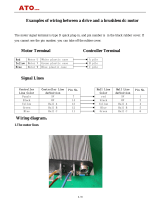
SAFETY
4262932-Rev A 1-9
1
Handle Fuel Safely
Handle fuel with care—it is highly flammable.
!
WARNING
Store fuel according to local, state, or federal ordinances
and recommendations from your fuel supplier.
Never overfill or allow the tank to become empty.
Use clean, fresh fuel.
Do not fill above the fuel filler neck.
Store Volatile and Hazardous
Materials Safely
Store volatile materials in approved containers that are
clearly marked. Containers should be stored in an
approved safety cabinet away from possible sources of
ignition. Storage areas and cabinets should be well
ventilated to prevent the possible buildup of fumes.
Handle Chemical Products
Safely
!
WARNING
Routine service often requires the use of various
chemical products, including lubricants and cleaning
solutions. Many of these chemicals are flammable and
can pose health risks if not handled properly.
• Never mix chemicals. Mixing chemicals can produce
toxic or explosive results.
• Follow the manufacturer’s recommendations for safe
usage and handling of the product.
• Various materials may pose a health hazard if used
incorrectly. A Material Safety Data Sheet (MSDS)
contains important information regarding proper
handling and health hazards, as well as emergency
response procedures. Contact the chemical
manufacturer to obtain an MSDS for the chemical
product.
Service Electrical Components
Safely
!
WARNING
• Disconnect the battery negative (–) cable before
removing or installing electrical components. Always
connect the battery negative (–) cable last.
• Certain test and adjustment procedures must be
performed with the battery connected. Use care to
prevent arcing when working on live circuits or
components. Arcing can cause component damage
and could ignite flammable materials.
• Never remove the fuel cap from the fuel tank,
or add fuel, when the engine is running or
while the engine is hot.
• Do not smoke when handling fuel. Never fill
or drain the fuel tank indoors.
• Do not spill fuel. Clean spilled fuel
immediately.
• Never handle or store fuel containers near an
open flame or any device that may create
sparks and ignite the fuel or fuel vapors.
• Be sure to reinstall and tighten fuel cap
securely.
• Use an approved container; the spout must fit
inside the fuel filler neck. Avoid using cans
and funnels to transfer fuel.
Exposure to chemical products could result in
serious injury. Handle chemical products with
care. Refer to the chemical manufacturer’s
Material Safety Data Sheet (MSDS) for
information regarding health hazards, safe
handling, and emergency response procedures.
Always disconnect the negative terminal first and
positive terminal last. Connect the positive
terminal first and negative terminal last. Use care
when testing live circuits to prevent arcing.
Arcing could result in death or serious injury.
























